Tags
American Academy of Orthopaedic Surgeons, bearing surface, DePuy, Hip Replacement, joint replacement, Orthopedic surgery, surgery, UNited States
Bearing Surface
The Registry is reporting on five different bearing surfaces with more than 200 procedures. There are a small number of procedures where the bearing surface is reported as ‘Other’. This group contains procedures where the bearing surface is yet to be classified or where the bearing surface combinations have less than 200 procedures (Tables HT29 and HT30).

 Ceramicised metal is reported as a separate bearing surface for the first time. This has a shorter follow up than other bearing surfaces and has largely been combined with modified polyethylene. Comparisons to other bearing surfaces should be interpreted with caution.
Ceramicised metal is reported as a separate bearing surface for the first time. This has a shorter follow up than other bearing surfaces and has largely been combined with modified polyethylene. Comparisons to other bearing surfaces should be interpreted with caution.
Metal on Metal
Metal/metal bearing surface has the highest risk of revision compared to all other bearing surfaces (Figure HT18).
 The difference between metal/metal and other bearing surfaces is not evident when the head size is 28mm or less (Tables HT31 and HT32 and Figures HT19 and HT20).
The difference between metal/metal and other bearing surfaces is not evident when the head size is 28mm or less (Tables HT31 and HT32 and Figures HT19 and HT20).



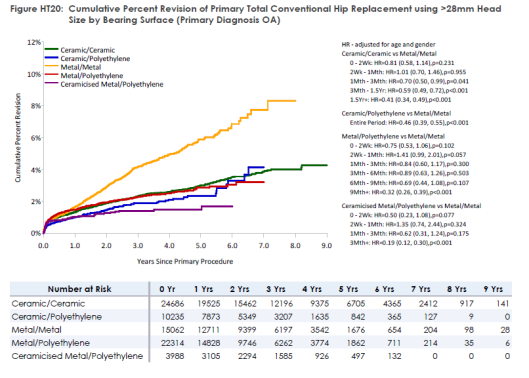 There is a difference when the head size is greater than 28mm. In this group, the cumulative percent revision at seven years is 7.7% for metal/metal, compared to 3.9% for ceramic/ceramic, 4.1% for ceramic/polyethylene and 3.2% for metal/polyethylene.
There is a difference when the head size is greater than 28mm. In this group, the cumulative percent revision at seven years is 7.7% for metal/metal, compared to 3.9% for ceramic/ceramic, 4.1% for ceramic/polyethylene and 3.2% for metal/polyethylene.
To further evaluate the effect of head size with metal/metal bearing surface, analysis was undertaken comparing four head size groups (≤28, 30‐32, 36‐40, >40mm) (Tables HT33 and HT34 and Figure HT21).


 The two larger head size groups were associated with an increased risk of revision compared to the two groups with head sizes 32mm or less. The higher risk of revision for head sizes greater than 32mm becomes evident after two years (Tables HT35 and HT36 and Figure HT22).
The two larger head size groups were associated with an increased risk of revision compared to the two groups with head sizes 32mm or less. The higher risk of revision for head sizes greater than 32mm becomes evident after two years (Tables HT35 and HT36 and Figure HT22).


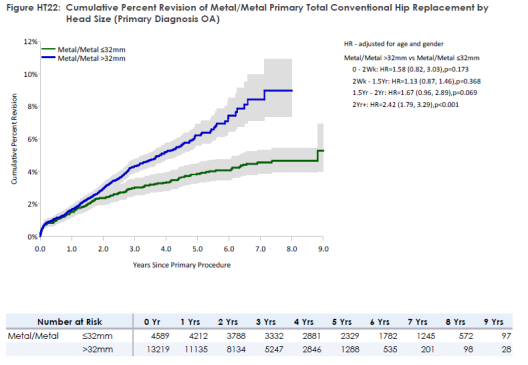 Initial age related analysis did not show any difference in the risk of revision for metal/metal bearing surfaces (Tables HT37 and HT38 and Figure HT23).
Initial age related analysis did not show any difference in the risk of revision for metal/metal bearing surfaces (Tables HT37 and HT38 and Figure HT23).


 There is an interaction between age and head size. The risk of revision for head sizes larger than 32mm is higher regardless of age and this risk is greater the younger the patient (Tables HT39 and HT40 and Figure HT24).
There is an interaction between age and head size. The risk of revision for head sizes larger than 32mm is higher regardless of age and this risk is greater the younger the patient (Tables HT39 and HT40 and Figure HT24).


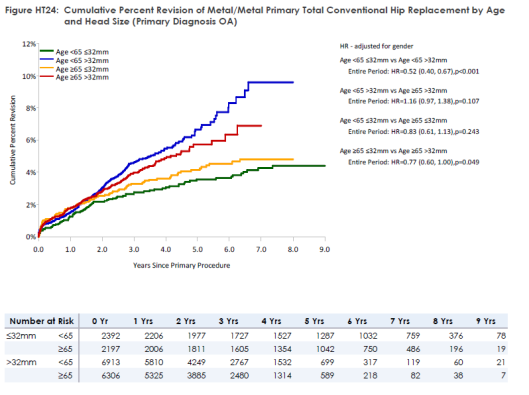
Females have a higher risk of revision (Tables HT41 and HT42 and Figure HT25).


 This is only evident for head sizes greater than 32mm (Tables HT43 and HT44 and Figure HT26).
This is only evident for head sizes greater than 32mm (Tables HT43 and HT44 and Figure HT26).


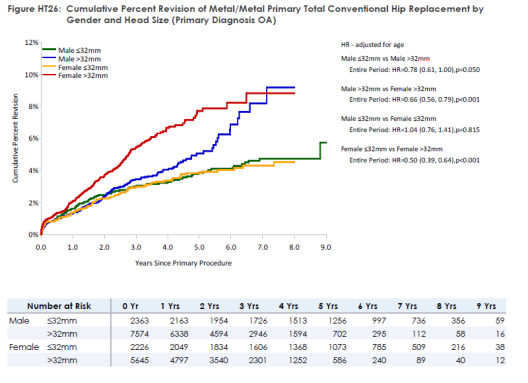 Cumulative incidence of reasons for revision with respect to time are also presented. Comparing metal/metal to metal/polyethylene there is a higher incidence of revisions for loosening/lysis and metal sensitivity for the metal/metal group. The cumulative incidence at nine years for these two revision diagnoses for metal/metal is 3.3% and 0.5% respectively compared to metal/polyethylene 1.8% and 0.0% respectively (Figure HT27).
Cumulative incidence of reasons for revision with respect to time are also presented. Comparing metal/metal to metal/polyethylene there is a higher incidence of revisions for loosening/lysis and metal sensitivity for the metal/metal group. The cumulative incidence at nine years for these two revision diagnoses for metal/metal is 3.3% and 0.5% respectively compared to metal/polyethylene 1.8% and 0.0% respectively (Figure HT27).

These differences are more evident in the greater than 32mm head size for metal/metal (Figure HT28).

Metal sensitivity has only been reported for metal/metal articulations and is largely confined to head sizes greater than 32mm. At nine years, cumulative incidence of metal sensitivity is 0.7% for head sizes greater than 32mm and 0.1% for head sizes less than 32mm. The incidence of metal sensitivity is potentially higher as it is possible that undiagnosed metal sensitivity contributes to the increased rate of loosening/lysis in metal/metal articulations with larger head sizes (Figure HT28).

In order to determine if the higher revision rate of metal/metal articulations with greater than 32mm head sizes is prosthesis specific, the Registry has analysed all prostheses head/acetabular combinations with more than 200 procedures. There are 12 combinations that meet these criteria, many contribute to the higher revision rate (Tables HT45 and HT46).
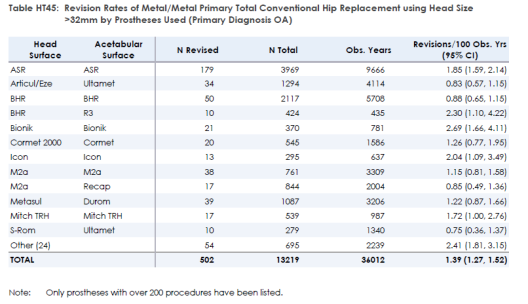

Modified Polyethylene
For the first time the Registry is reporting the outcome of modified polyethylene. This includes polyethylene
that is cross‐linked or has the addition of Vitamin E. At this time, the number of ‘E‐poly’ prostheses reported to the Registry is small so they have not been separately analysed. Non‐modified polyethylene includes all other polyethylene. Modified polyethylene has a lower risk of revision compared to non‐modified polyethylene (Tables HT47 and HT48 and Figure HT29).



At this time there is no difference in the risk of revision for modified polyethylene related to head size (≤32 and >32mm). This is also true for non‐modified polyethylene, however the numbers are small for head sizes greater than 32mm (Tables HT49 and HT50 and Figure HT30).



Related articles
- Australian Orthopaedic Association National Joint Replacement Registry – Annual Report 2010 (earlsview.com)
- The Holy Grail of Orthopaedics – Can We Achieve the Revision-Free Implant? (earlsview.com)
- ANALYSIS OF BEARING-SURFACE-RELATED COMPLICATIONS [Hip] (earlsview.com)
- Revision Hip Replacement (RHR) (earlsview.com)
- MUSC Reconstruction Experts Address Metal-on-Metal Joint Replacement Device Controversy (earlsview.com)
- Associate Professor Michael J. Neil – Doesn’t Recommend Resurfacing (earlsview.com)
- Ceramic Hip Joint Replacement Devices (earlsview.com)
- ‘Metal on metal’ hip implants leave some recipients in pain, at risk (earlsview.com)
- Mr McMinn, Inventor of the BHR Gives A Balanced Response to ABC 4Corners Program (earlsview.com)
